Urban Outfitters Bundle
Who Shops at Urban Outfitters?
The retail industry is constantly evolving, and understanding the Urban Outfitters SWOT Analysis is crucial for success. This exploration delves into the core of Urban Outfitters' strategy: its customer demographics and target market. We'll uncover the intricate details of the Urban Outfitters consumer profile, examining their preferences and how the brand adapts to meet their needs. This is not just about sales; it is about building lasting relationships in a competitive market.
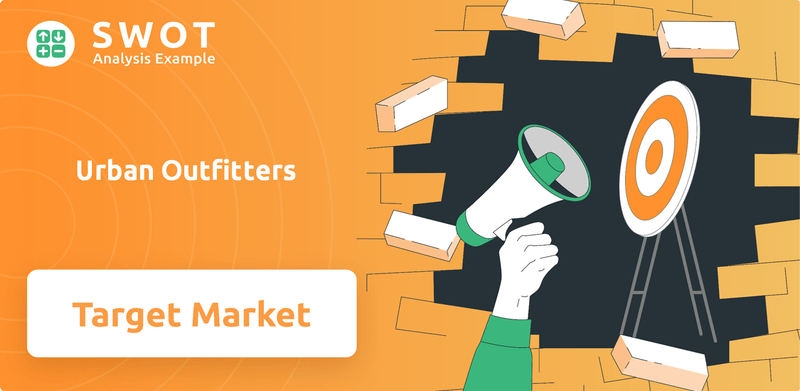
From its roots in counter-culture to its current position in the retail industry, Urban Outfitters has consistently adapted its approach. This analysis examines the brand's market segmentation, exploring the Urban Outfitters customer age range, income levels, and lifestyle choices. By understanding these nuances, we can better grasp Urban Outfitters' brand perception and its ability to cultivate customer loyalty through tailored shopping experiences and relevant product offerings.
Who Are Urban Outfitters’s Main Customers?
Understanding the Growth Strategy of Urban Outfitters requires a deep dive into its customer demographics and target market. The company strategically positions its brands to appeal to diverse, yet specific, consumer segments within the retail industry. This approach allows for a broad reach while maintaining brand relevance and customer loyalty.
The primary customer segments are defined by age, lifestyle, and spending habits. Each brand within the portfolio, such as Urban Outfitters, Anthropologie, and Free People, caters to a distinct consumer profile. This segmentation strategy is crucial for product development, marketing campaigns, and overall business success.
The company's success hinges on its ability to understand and cater to the evolving preferences of its target market. Continuous market research and analysis of customer shopping habits are essential to staying ahead in the competitive retail landscape.
The flagship brand, Urban Outfitters, primarily targets young adults aged 18-24. This segment includes college students and recent graduates. They are drawn to current fashion trends, vintage-inspired aesthetics, and pop culture.
Anthropologie caters to women aged 28-45. This demographic appreciates unique, artisan-inspired clothing, accessories, and home furnishings. They generally have higher disposable income and seek quality, distinctive pieces.
Free People appeals to young women aged 25-30, known for its bohemian, free-spirited, and romantic aesthetic. This customer base values comfort, versatility, and a connection to nature and wellness.
The company continually refines its target market within each brand, adapting to evolving fashion cycles and consumer preferences. This strategic agility ensures sustained relevance and appeal. In 2024, the company reported that the Urban Outfitters brand saw a 6% increase in comparable sales, while Anthropologie's comparable sales grew by 8%. Free People also demonstrated strong performance, reflecting the success of its targeted approach.
Understanding the nuances of each brand's customer demographics is crucial for effective marketing and product development. Analyzing customer shopping habits and spending patterns helps tailor offerings to meet specific needs and preferences. The company's market segmentation strategy is a key driver of its success in the competitive retail industry.
- Urban Outfitters: Focuses on trendy apparel, accessories, and home decor for young adults.
- Anthropologie: Offers unique clothing, accessories, and home furnishings for a more mature, affluent clientele.
- Free People: Caters to a bohemian, free-spirited customer base with comfortable and versatile clothing.
- Customer Loyalty: The company's customer loyalty program, offers rewards and exclusive benefits, fostering repeat purchases and brand affinity.
Urban Outfitters SWOT Analysis
- Complete SWOT Breakdown
- Fully Customizable
- Editable in Excel & Word
- Professional Formatting
- Investor-Ready Format
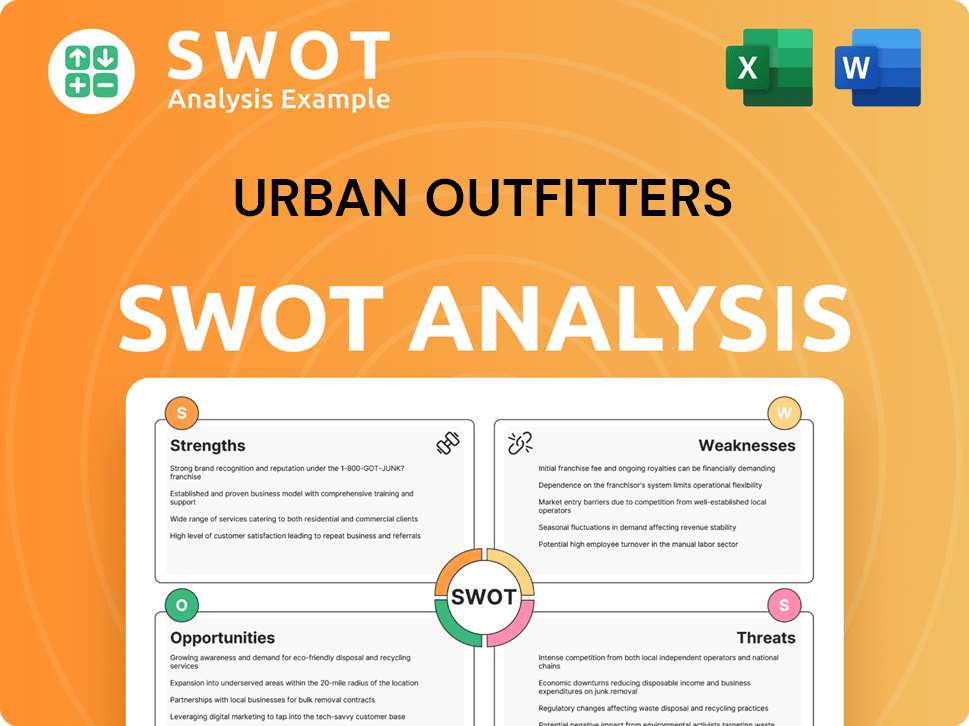
What Do Urban Outfitters’s Customers Want?
Understanding the customer needs and preferences is crucial for the success of any business, especially in the dynamic retail industry. For Urban Outfitters, this involves a deep dive into the consumer profile to tailor products and marketing strategies effectively. The company's target market, characterized by specific demographics and psychographics, drives its overall business model.
The core of Urban Outfitters' appeal lies in its ability to resonate with customers who value self-expression, individuality, and a lifestyle that aligns with the brand's aesthetic. This understanding allows the company to curate collections and experiences that meet the evolving demands of its customer base. A thorough analysis of the target market reveals key insights into their motivations and purchasing behaviors.
Urban Outfitters' customers are driven by a desire for unique, trend-forward items that allow them to express their individuality. They are often influenced by social media trends, peer validation, and the aspiration to curate a distinctive personal style. Decision-making criteria frequently include a blend of aesthetic appeal, perceived value, and the emotional connection to the brand's identity, influencing their shopping habits.
The Urban Outfitters customer demographic is characterized by specific preferences that shape their buying behavior. These preferences include a strong interest in fashion-forward apparel, home goods, and lifestyle products. Understanding these preferences is vital for effective market segmentation and targeted marketing strategies.
- Fashion-Forward Apparel: Customers seek trendy clothing that reflects current styles and allows for self-expression.
- Home Goods and Décor: There is a demand for unique and stylish home furnishings that create a personalized living space.
- Lifestyle Products: Interest in items that complement a curated lifestyle, including accessories, beauty products, and gifts.
- Brand Identity: Customers are drawn to brands with a strong identity and values that align with their own.
- Online Shopping: A significant portion of the customer base prefers the convenience of online shopping and mobile apps.
Urban Outfitters PESTLE Analysis
- Covers All 6 PESTLE Categories
- No Research Needed – Save Hours of Work
- Built by Experts, Trusted by Consultants
- Instant Download, Ready to Use
- 100% Editable, Fully Customizable
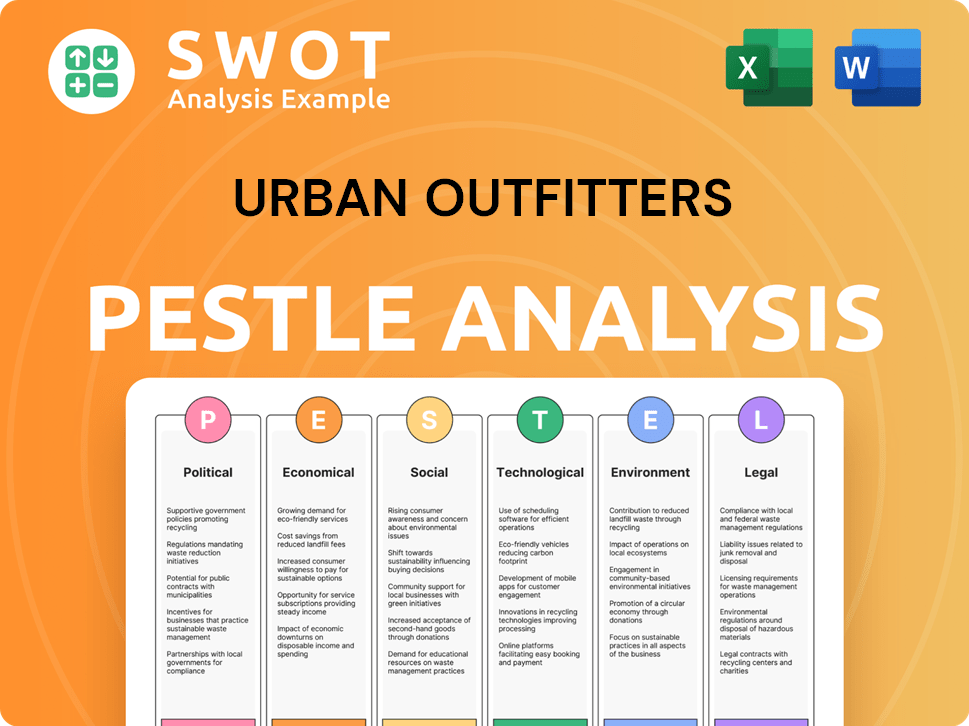
Where does Urban Outfitters operate?
The geographical market presence of Urban Outfitters, Inc. is largely concentrated in North America and Europe, reflecting a strategic focus on these key regions. The United States serves as the primary market, with a significant number of stores located in major metropolitan areas and college towns. This strategic placement aligns with the company's historical and current customer demographics, ensuring accessibility to its target market.
Canada also represents a notable market for all three core brands of Urban Outfitters, Inc. In Europe, the United Kingdom is a critical market, alongside other Western European countries such as France, Germany, and the Netherlands. These regions have a strong market share and brand recognition for Urban Outfitters, Anthropologie, and Free People.
The company continues to strategically expand its physical presence in key urban centers while leveraging its robust e-commerce platforms to reach a broader international audience. Recent expansions have focused on optimizing store locations and enhancing online fulfillment capabilities to better serve diverse markets. For a deeper understanding of the company's origins, you can explore the Brief History of Urban Outfitters.
In North America, the customer demographics for Urban Outfitters are primarily concentrated in the United States. The target market includes young adults and millennials, aged roughly between 18 and 35 years old. These customers are often characterized by their interest in fashion, art, music, and a lifestyle that embraces individuality.
European customer demographics show similar trends, with a focus on young adults and millennials. However, there might be a stronger emphasis on sustainability and local designs. Urban Outfitters adapts its offerings and marketing to cater to regional tastes. This includes tailoring product selections and marketing messages to align with cultural nuances.
Urban Outfitters employs market segmentation to target different customer groups. This involves dividing the market into segments based on demographics, lifestyle, and preferences. The company uses data analytics to understand customer behavior and tailor its products and marketing campaigns. This strategy helps in effective targeting and brand positioning.
Urban Outfitters has a strong e-commerce presence to reach a broader international audience. The online platform provides detailed customer data, including demographics and shopping habits. The company focuses on enhancing online fulfillment capabilities to better serve diverse markets. This includes optimizing website design and user experience.
Urban Outfitters strategically places its stores in key locations to reach its target market. These locations include major metropolitan areas and college towns in the United States and the United Kingdom. The company also has a presence in other Western European countries. This strategic placement ensures accessibility and brand visibility.
- United States: Major cities and college towns.
- United Kingdom: Urban centers.
- Western Europe: France, Germany, Netherlands.
- Canada: Select locations.
Urban Outfitters Business Model Canvas
- Complete 9-Block Business Model Canvas
- Effortlessly Communicate Your Business Strategy
- Investor-Ready BMC Format
- 100% Editable and Customizable
- Clear and Structured Layout
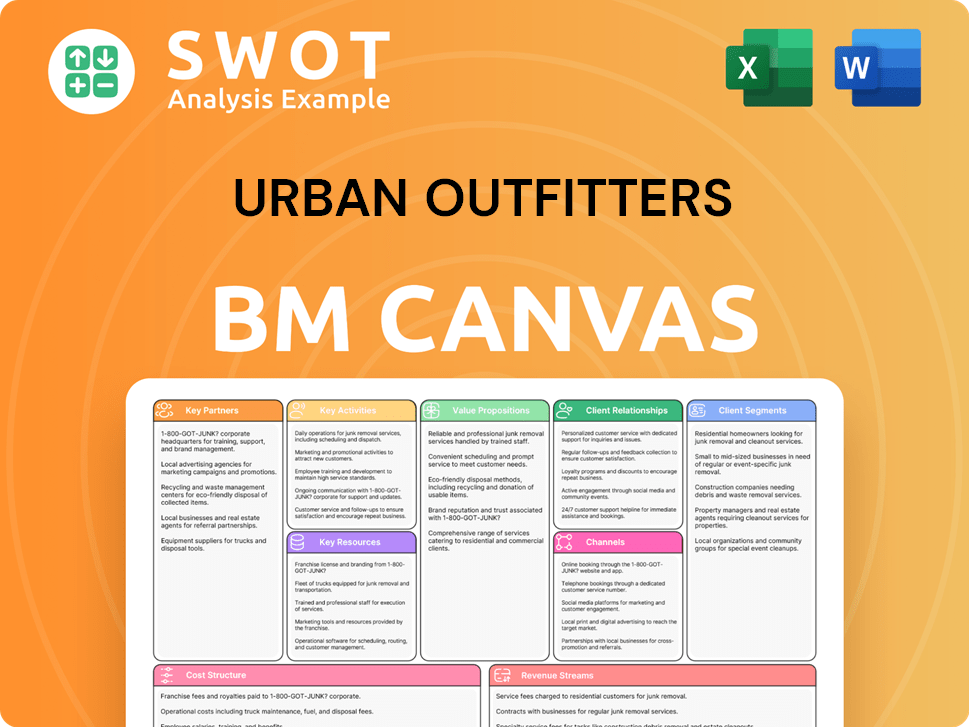
How Does Urban Outfitters Win & Keep Customers?
The company employs a sophisticated customer acquisition and retention strategy, leveraging both digital and traditional marketing channels. Digital marketing, including social media campaigns on platforms like Instagram and TikTok, is crucial for reaching its target market. Email marketing and personalized online recommendations also play a key role in driving repeat purchases and fostering customer loyalty.
Traditional marketing methods include in-store events, visual merchandising to create an immersive shopping experience, and occasional print catalogs, particularly for the Anthropologie brand. Sales tactics often involve limited-time promotions, collaborations with popular brands or artists, and curated collections that generate excitement and urgency, all designed to attract and retain customers. Their focus on data-driven and personalized approaches has significantly improved customer loyalty.
Customer data and CRM systems are vital for segmenting customers and personalizing marketing efforts, allowing for targeted product recommendations and tailored communications. Successful acquisition campaigns often go viral on social media, driven by user-generated content and lifestyle imagery. Innovative retention initiatives include exclusive online content, styling advice, and community-building efforts that extend beyond transactions. This strategic approach, which includes a strong understanding of Revenue Streams & Business Model of Urban Outfitters, has significantly contributed to the company's customer base and brand perception.
The company heavily relies on digital marketing, utilizing social media platforms like Instagram, TikTok, and Pinterest. Visual content and influencer collaborations are key to reaching the target audience. Email marketing and personalized online recommendations are also crucial for driving repeat purchases.
Traditional marketing includes in-store events, visual merchandising, and print catalogs. Visual merchandising creates an immersive shopping experience. Print catalogs are used, especially for the Anthropologie brand.
Sales tactics involve limited-time promotions, collaborations, and curated collections. These strategies generate excitement and urgency, encouraging purchases. Loyalty programs, through personalized discounts, foster a sense of exclusivity.
Customer data and CRM systems are used to segment customers for targeted campaigns. This enables personalized product recommendations and tailored communications. The company has shifted to a more data-driven approach.
Social media campaigns are a cornerstone of the company's marketing strategy. Platforms like Instagram and TikTok are used extensively. These campaigns feature visual content and influencer collaborations to attract the target market.
Email marketing and personalized online recommendations are critical for driving repeat purchases. They contribute significantly to customer retention. These strategies help to build customer loyalty.
In-store events and visual merchandising create immersive shopping experiences. These experiences enhance customer engagement. Visual merchandising is a key element of the brand's appeal.
Loyalty programs, often through personalized discounts, foster a sense of exclusivity. These programs help to retain repeat customers. They are a key component of the retention strategy.
The company has shifted towards a more data-driven and personalized approach. This focus has positively impacted customer loyalty. Data analytics are used to understand customer behavior.
Innovative retention initiatives include exclusive online content and styling advice. Community-building efforts extend beyond mere transactions. These efforts enhance customer engagement.
Urban Outfitters Porter's Five Forces Analysis
- Covers All 5 Competitive Forces in Detail
- Structured for Consultants, Students, and Founders
- 100% Editable in Microsoft Word & Excel
- Instant Digital Download – Use Immediately
- Compatible with Mac & PC – Fully Unlocked
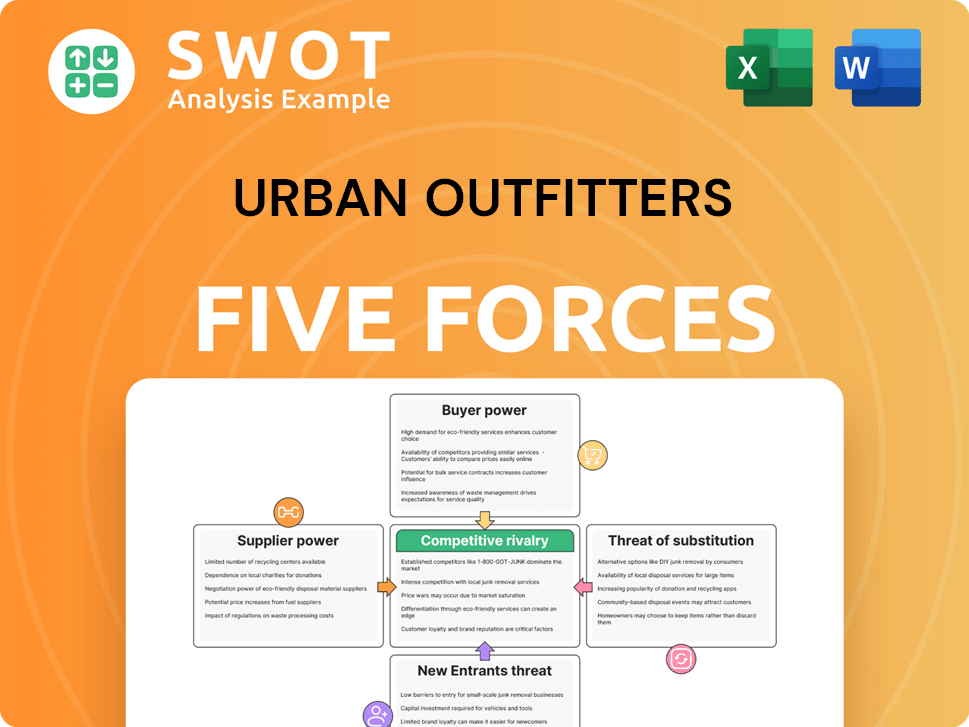
Related Blogs
- What are Mission Vision & Core Values of Urban Outfitters Company?
- What is Competitive Landscape of Urban Outfitters Company?
- What is Growth Strategy and Future Prospects of Urban Outfitters Company?
- How Does Urban Outfitters Company Work?
- What is Sales and Marketing Strategy of Urban Outfitters Company?
- What is Brief History of Urban Outfitters Company?
- Who Owns Urban Outfitters Company?
Disclaimer
All information, articles, and product details provided on this website are for general informational and educational purposes only. We do not claim any ownership over, nor do we intend to infringe upon, any trademarks, copyrights, logos, brand names, or other intellectual property mentioned or depicted on this site. Such intellectual property remains the property of its respective owners, and any references here are made solely for identification or informational purposes, without implying any affiliation, endorsement, or partnership.
We make no representations or warranties, express or implied, regarding the accuracy, completeness, or suitability of any content or products presented. Nothing on this website should be construed as legal, tax, investment, financial, medical, or other professional advice. In addition, no part of this site—including articles or product references—constitutes a solicitation, recommendation, endorsement, advertisement, or offer to buy or sell any securities, franchises, or other financial instruments, particularly in jurisdictions where such activity would be unlawful.
All content is of a general nature and may not address the specific circumstances of any individual or entity. It is not a substitute for professional advice or services. Any actions you take based on the information provided here are strictly at your own risk. You accept full responsibility for any decisions or outcomes arising from your use of this website and agree to release us from any liability in connection with your use of, or reliance upon, the content or products found herein.